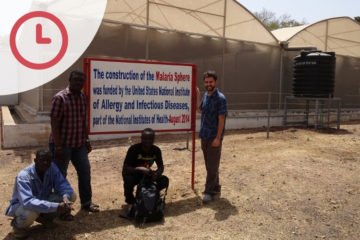Podcast Available on iTunes and Spotify.
Hello, I’m Thomas Locke and this is Five Minutes, the podcast that brings you closer to the malaria experts.
All of our genetic material is made from DNA. It’s a chemical found in the nucleus of our cells, in long structures called chromosomes. The entire set of our genetic material forms our genome; each one of ours is unique. Having reference genomes, a list of the genes always occur in a particular species is really important. It allows scientists to identify genes that cause disease, understand genetic inheritance and track migration patterns. Or in the case of malaria, understand insecticide resistance.
But due to limited DNA samples, creating reference genomes for mosquitos is a challenge. The most accurate mosquito genome is of the Anopheles gambiae species, published in 2002. But even that has gaps and acts as a ‘chromosomic scaffold’. However, a new way of generating genomes is allowing scientists to fill these genetic gaps. In a partnership between the Sanger Institute and PacBio, a high-quality genome can be made from just 100 nanograms of DNA – compared to the 5 micrograms which were needed before.
Joining me now is Sarah Kingan, a scientist who helped develop the new protocol.
Sarah, thanks for joining me.
You’re welcome.
Could you tell me more about genome sequencing?
As you probably know, the genome is organised into chromosomes. The goal of genome assembly is to reconstruct the sequence of DNA bases along each of those chromosomes. Ideally, for a species like a mosquito, we would wish to have 10 complete sequences representing the five chromosomes inherited from the mother and the five chromosomes inherited from the father. The way we do genome assembly is to generate millions, sometimes tens or even hundreds of millions, of DNA sequences and then use these to reconstruct the chromosome sequences. An analogy that’s often used is doing a jigsaw puzzle – each of the puzzle pieces represents a DNA sequence read, the goal is to assemble the complete picture of each chromosome.
The mosquito genome that we published was sequenced with PacBio technology which can generate long reads 20-30 thousand base pairs or even longer. And just like a children’s jigsaw puzzle, which has very few large pieces, using long PacBio reads makes the genome assembly problem much easier.
In the past, mosquito genomes have been made using five micrograms of DNA. How is your protocol different?
The protocol that we developed was done in collaboration with the Sanger Institute and the R&D team at PacBio. We modified our existing library protocol to prevent loss of the material that’s needed for sequencing. When we sequence for de novo genome assembly, we do what’s called ‘size selection’, so we remove the shorter DNA fragments prior to loading the sample on the machine and that leaves only the longest DNA fragments which are best for genome assembly. Our protocol eliminates the size selection step in order to preserve all the material that we have.
In addition, rather than fragmenting the DNA sample, we extracted DNA from a bunch of different mosquitoes and during the DNA extraction process, you naturally kind of break the DNA up into smaller pieces. We looked at the DNA extracted from many different mosquitoes and chose a sample that had the right size profile for sequencing. And then the last thing we did, was just using a newer version of our library prep kit which you don’t have to transfer the material between different tubes – it’s an addition only protocol, and that also further prevents any loss of material.
Talking very literally about DNA collection. How do you acquire the DNA samples from the mosquito considering their very small size?
Right. Well, there are a lot of commercial kits out there available. You just collect a mosquito, throw it in a plastic tube, grind it up and then there is a bunch of different buffers and washes that you use to extract the genomic DNA. So, there’s a lot of widely available commercial kits that are that are available.
Talking more holistically about global malaria prevalence. Now you’ve got this new protocol and now you can sequence the DNA, what would this enable researchers and people in the field to do?
Yeah, it’s really exciting because it allows us to look at genetic variation within species for traits like insecticide resistance. In order to really study those types of traits that are important for vector population control. You need a really good reference genome.
Sarah Kingan, thanks very much.
Thank you so much, Thomas.


